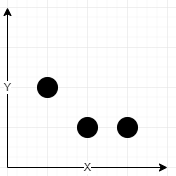题目如下:
You are given an array of network towers
towersand an integerradius, wheretowers[i] = [xi, yi, qi]denotes theithnetwork tower with location(xi, yi)and quality factorqi. All the coordinates are integral coordinates on the X-Y plane, and the distance between two coordinates is the Euclidean distance.The integer
radiusdenotes the maximum distance in which the tower is reachable. The tower is reachable if the distance is less than or equal toradius. Outside that distance, the signal becomes garbled, and the tower is not reachable.The signal quality of the
ithtower at a coordinate(x, y)is calculated with the formula⌊qi / (1 + d)⌋, wheredis the distance between the tower and the coordinate. The network quality at a coordinate is the sum of the signal qualities from all the reachable towers.Return the integral coordinate where the network quality is maximum. If there are multiple coordinates with the same network quality, return the lexicographically minimum coordinate.
Note:
- A coordinate
(x1, y1)is lexicographically smaller than(x2, y2)if eitherx1 < x2orx1 == x2andy1 < y2.⌊val⌋is the greatest integer less than or equal toval(the floor function).Example 1:
Input: towers = [[1,2,5],[2,1,7],[3,1,9]], radius = 2 Output: [2,1] Explanation: At coordinate (2, 1) the total quality is 13 - Quality of 7 from (2, 1) results in ⌊7 / (1 + sqrt(0)⌋ = ⌊7⌋ = 7 - Quality of 5 from (1, 2) results in ⌊5 / (1 + sqrt(2)⌋ = ⌊2.07⌋ = 2 - Quality of 9 from (3, 1) results in ⌊9 / (1 + sqrt(1)⌋ = ⌊4.5⌋ = 4 No other coordinate has higher quality.Example 2:
Input: towers = [[23,11,21]], radius = 9 Output: [23,11]Example 3:
Input: towers = [[1,2,13],[2,1,7],[0,1,9]], radius = 2 Output: [1,2]Example 4:
Input: towers = [[2,1,9],[0,1,9]], radius = 2 Output: [0,1] Explanation: Both (0, 1) and (2, 1) are optimal in terms of quality but (0, 1) is lexicograpically minimal.Constraints:
1 <= towers.length <= 50towers[i].length == 30 <= xi, yi, qi <= 501 <= radius <= 50
解题思路:最直接的办法就是穷举了,找出信号塔能覆盖的x与y的最大值和最小值,然后计算这个区间内所有的(x,y),找出最大值。
代码如下:
class Solution(object): def bestCoordinate(self, towers, radius): """ :type towers: List[List[int]] :type radius: int :rtype: List[int] """ import math max_quality = 0 max_x = 0 max_y = 0 dic = {} def calc(x1,y1,x2,y2): return math.sqrt((x1-x2)*(x1-x2) + (y1-y2)*(y1-y2)) def cmpf(x1,y1,x2,y2): if x1 != x2: return x1 - x2 return y1 - y2 for (x,y,q) in towers: max_x = max(max_x,x+radius) max_y = max(max_y,y+radius) for i in range(max_x+1): for j in range(max_y+1): if i == 2 and j == 1: pass for (x,y,q) in towers: d = calc(i,j,x,y) if d > radius: continue dic[(i, j)] = dic.setdefault((i, j), 0) + math.floor(float(q) / float(1 + d)) max_quality = max(max_quality,dic[i,j]) #print max_quality if max_quality == 0: return [0,0] res = [] for (x,y),val in dic.iteritems(): if val == max_quality: if len(res) == 0 :res = [x,y] elif cmpf(res[0],res[1],x,y) > 0: res = [x,y] return res
